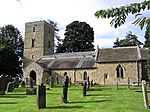Bitchfield Tower

Bitchfield Tower or West Bitchfield Tower is a 15th-century medieval pele tower near Belsay, Northumberland, England. It is a Grade I listed building.The three storied battlemented tower was built in the 15th century by the Middleton family who sold it to the Harbottles in 1502. Marjorie Harbottle the heiress to the Harbottle estate, married Sir John Fenwick of Fenwick Tower and in 1529 they conveyed the property to their second son Roger Fenwick. In 1622 Robert Fenwick built a new manor house adjoining the tower: a datestone inscribed 'RF 1622 JF' is incorporated into the buildingThe Fenwicks sold the estate in 1630 to Edward Grey, from whom it was sequestered in 1646. In 1680 it was acquired by Sir James Clavering and in 1802 the Claverings sold to Sir Charles Monck.It was in a state of ruin by 1930 but has since been restored. The east wing was added by Caroë and Lord Gort in 1935. The tower was listed since August 27th, 1952.
Excerpt from the Wikipedia article Bitchfield Tower (License: CC BY-SA 3.0, Authors, Images).Bitchfield Tower
Geographical coordinates (GPS) Address Nearby Places Show on map
Geographical coordinates (GPS)
| Latitude | Longitude |
|---|---|
| N 55.089 ° | E -1.857 ° |
Address
White Law
NE20 0JH
England, United Kingdom
Open on Google Maps









